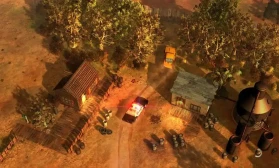Title: Into the Digital Abyss: The "Scorpion Den Shelter Sign Installer Simulator VR" Place Missions Update Deep Dive
The virtual reality landscape is perpetually evolving, pushing beyond the boundaries of high-octane shooters and fantastical RPGs into the strangely compelling realm of hyper-simulated, mundane labor. Standing at the pinnacle of this niche is the critically acclaimed, cult hit Scorpion Den Shelter Sign Installer Simulator VR. This isn't a game for the faint of heart; it’s a test of patience, precision, and intestinal fortitude. The recent "Place Missions" update isn't just a patch; it's a fundamental expansion that redefines the very soul of the experience, transforming a quirky simulator into a profound narrative of hope and resilience.
For the uninitiated, the core premise of Scorpion Den Shelter is deceptively simple. You are a freelance sign installer, contracted by the mysterious "Urban Renewal & Outreach Collective," tasked with navigating the treacherous, crime-ridden dystopian metropolis of Neo-Kyiv to find and install illuminated sanctuary signs on designated safe houses—the Scorpion Dens. The original gameplay loop was a masterclass in tension: meticulously planning a route through gang-controlled districts, managing your limited battery-powered tools, and executing the physical installation under the threat of roaming thugs, all while the city's haunting, rain-slicked neon glow provided a breathtakingly bleak backdrop.
The "Place Missions" update shifts the paradigm from pure execution to strategic establishment. Previously, the game provided you with coordinates. Your job was to go there and install. Now, the Collective’s operations have expanded. The update introduces a new layer: you are no longer just an installer; you are a scout, a strategist, the first point of contact for hope in a dying city.
The missions begin in a new, secure operations hub—a repurposed shipping container lit by flickering holographic maps. Here, you receive requests for new shelter locations. These aren't precise GPS pins. The data is fragmented: a desperate audio message from a community leader describing a "sturdy basement near the old ferro-core refinery," or a corrupted text file hinting at a structurally sound apartment block with a "clear sightline from the northern expressway." Using this intelligence, you must first place the potential den.
This placement phase is where the update truly shines in VR. You are thrust into the proposed location, which is often hostile, unexplored, and dark. Your new tool, the Structural Integrity Scanner (SIS), must be deployed. Physically holding the scanner up to load-bearing walls, checking for corrosion on support beams with your free hand, and assessing entry/exit points becomes a nerve-wracking mini-game. The sound design is impeccable—the low hum of the SIS, the distant echo of sirens and shouts, and the frantic beating of your own heart through the haptic feedback in the VR controllers. A miscalculation here—placing the sign on a weak structure or in an area with no escape routes—dooms the shelter before it even opens. The weight of this responsibility is palpable.
Once a location is scanned and deemed viable, you must physically "tag" it by deploying a small, beacon-like device from your belt. This moment is arguably the most tense in the entire game now. The beacon’s activation sequence takes a solid 60 seconds, during which you are utterly vulnerable. You can’t hold a weapon; your hands are busy stabilizing the beacon. You are a sitting duck, forced to watch the shadows in the alleyway, listening for the tell-tale scrape of boots on concrete, hoping your assessment of the area’s temporary safety was correct. The successful placement of the beacon unlocks the classic installation mission, now with the added context that you chose this spot. The emotional investment is profound.
Furthermore, the "Place Missions" update introduces a new faction: the Denizens. These are the future residents of the shelters you scout. Occasionally, during a placement mission, you might encounter a small group hiding in the location. Interacting with them is not through complex dialogue trees but through VR-driven gestures. Offering a ration pack from your inventory, helping to move a heavy obstruction to secure a back entrance, or simply giving a thumbs-up—these small actions build a connection. Later, when you return to install the full sign, you might see those same Denizens, now slightly cleaner and with a glimmer of hope in their eyes, beginning to clean the space. It’s a silent, powerful payoff that the original game lacked.

The update also expands the toolset. The rivet gun feels heavier, the wiring for the signs more complex, requiring genuine dexterity to connect under time pressure. The new environments for these placement missions are some of the most visually stunning and oppressive yet: a flooded shopping mall where you wade through chest-high, opaque water to reach a potential den, or a derelict monorail station where every creak of the metal structure above could be the wind or something far more sinister.
In conclusion, the "Place Missions" update for Scorpion Den Shelter Sign Installer Simulator VR is a monumental achievement. It successfully takes a game celebrated for its unique mechanics and layers on deep, meaningful narrative and emotional weight. It transforms the player from a passive contractor into an active architect of salvation within the dystopian hellscape of Neo-Kyiv. It’s no longer just about installing a sign; it’s about planting a flag. It’s about making a conscious choice to carve out a small pocket of light in an overwhelming darkness, and that is a far more compelling and human mission than any game about saving the galaxy has ever offered.
Tags: #ScorpionDenShelterVR #VRGaming #GameUpdate #SimulationGames #VirtualReality #DystopianGaming #IndieGame #PlaceMissions #GamingReview #TechInnovation
















